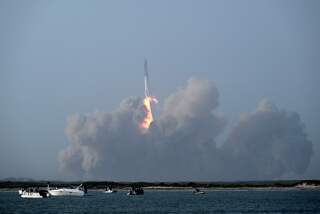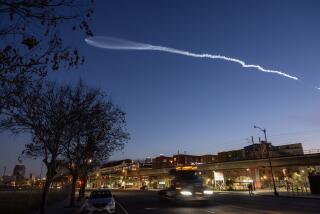Pentagon successful with latest missile-defense test off Pacific
The Missile Defense Agency breathed a sigh of relief after carrying out a successful flight test of an interceptor missile from Vandenberg Air Force Base, northwest of Santa Barbara.
Saturday’s test was on the Boeing-designed ground-based defense system’s ability to defend the U.S. from the threat of ballistic missile attacks.
It involved the launch of a three-stage interceptor from a silo on the base at 2 p.m. PST. After blastoff, the booster deployed the Exoatmospheric Kill Vehicle made by Raytheon Co. to a designated point in space.
Once separated from the booster, the kill vehicle executed a variety of preplanned maneuvers to collect performance data in space.
The test did not involve a dummy target missile to intercept.
“If a target missile were present, the Exoatmospheric Kill Vehicle would collide directly with the threat warhead to perform a hit-to-kill intercept,” the Missile Defense Agency said in a statement. “Engineering data from this test will be used to improve confidence for future intercept missions.”
The kill vehicle is designed to lock on and eliminate high-speed ballistic missile warheads in space using nothing more than the sheer force of impact, known as a “hit-to-kill” defense, according to Raytheon.
Although the mission was deemed successful, the Missile Defense Agency has had a mixed record with the Ground-based Midcourse Defense System in the past.
Flight testing of the system was halted in early 2011 after a guidance error resulted in a failed intercept in a December 2010 test.
“Returning to flight has been the top priority for the … program. We have used industry and government’s combined expertise to solve a complex technical issue related to what the interceptor’s Exoatmospheric Kill Vehicle experiences in space,” Boeing program director Norm Tew said in a statement. “Today’s success is an important step toward our next goal of a successful intercept test.”
The Missile Defense Agency did not say when the next test would take place.
In a statement, the agency said: “This test is the critical first step in returning ... to successful intercept testing.”
ALSO:
FAA grounds entire fleet of Boeing 787s
787 Dreamliner’s safety systems failed, NTSB says
Construction is complete on behemoth airship; first flight planned
More to Read
Sign up for Essential California
The most important California stories and recommendations in your inbox every morning.
You may occasionally receive promotional content from the Los Angeles Times.











